Today, a walk through one of the natural woodland areas on the property, near one of the creeks, revealed the first blooming Trillium ovatum of the season.
Trillium ovatum is a native of the west coast of North America, ranging from British Columbia to California, and east to Idaho, Montana, Wyoming and Colorado, and grows wild here on the property. Of the all native plants here, Trillium ovatum is perhaps the most elegant of our understory plants, and definitely my favorite. Each spring it becomes a challenge, and a thrill, to find them growing and blooming amidst all of the redwood sorrel and ferns.
Trillium ovatum is also known by many common names, including Pursh, Pacific Trillium, Trinity Flower, Woodlily, Western Wake Robin, or Western White Trillium. The name Wake Robin came about because the flowers were observed to appear early in the spring, around the time of the Robin’s arrival. A similar species, Trillium grandiflorum is more common on the east coast of North America, and is similar in appearance, except that Trillium ovatum has narrower flower petals.
This Trillium species ranges between 8-12 inches in height, and bears broad ovate leaves in a single whorl of three. You may hear this plant referred to as Trinity Flower, so named for the three leaves, three persistent sepals, and the three petal arrangement of the flowers.
The flowers of Trillium ovatum are usually upright, and borne on a short stalk above the leaves. The flower color is pure white, gradually changing to a deep rose-colored hue with age. Occasionally Trillium ovatum is found with flowers that initially open a shade of rose and retain that color throughout the bloom period.
On this walk along the northern creek bank, I only found a total of four Trillium ovatum that were blooming, one of which demonstrated the deep rose color. In the time we’ve been here, the only other area here where we have seen Trillium is in a steep shaded canyon on the Western flank of the property, and they are far from being a common sight here.
This is the first year that I’ve caught the Trilliums early enough in the season before the leaves have completely unfurled. I had no idea until today that as the flowers begin to open, the three leaves are still wrapped around the petals like a protective hood.
Native American peoples are known to have used Trillium ovatum as a medicinal herb. The Karok and Quileute used the juice of scraped rhizomes as a dermatologic aid, applying the residues to boils. The Paiute, Lummi and Skagit apparently used an infusion of the roots as an eye medicine. [1]
As beautiful as Trilliums are, if you encounter them in the woods, please don’t pick the flowers. Trilliums are very long-lived if left undisturbed. One plant was reportedly aged at 72 years! Although not rare along the west coast, due to habitat encroachment Trilliums are becoming less common regionally in some parts of the West. Trilliums grow from an underground rhizome. Each year after the flowers and leaves senesce, the plant becomes dormant, but will re-emerge from the same rhizome the following spring. Repeated picking of the flowers and leaves however interferes with the rhizome’s ability to gather and store the nutrients necessary for growth and survival.
Trillium also reproduces from seed, but it takes approximately two to three years for the seed to germinate, and at least six to seven years for a plant to bloom when started from seed. Seed dispersal in the wild is dependent on insects. The seed bears a conspicuous, yellow food-body, called an elaiosome, which is very attractive to ants. Ants gather the seeds, and then transport them to their nests. They then consume the oily elaiosome, discarding the inner seed, which can then later germinate.[2]
I would love to try propagating more Trillium here, but I’m not sure I have enough patience to wait seven years for them to grow and bloom! Our Trilliums here however are in undisturbed areas of the property, and hopefully will slowly propagate themselves over the coming years.
[1] Daniel E. Moerman’s Native American Ethnobotanical Database
[2] Mesler, M.R and Lu, K.L. Seed Dispersal of Trillium Ovatum (Liliacae) in Second Growth Redwood Forests. American Journal of Botany, Vol. 70, No. 10 (Nov. – Dec., 1983), pp. 1460-1467.

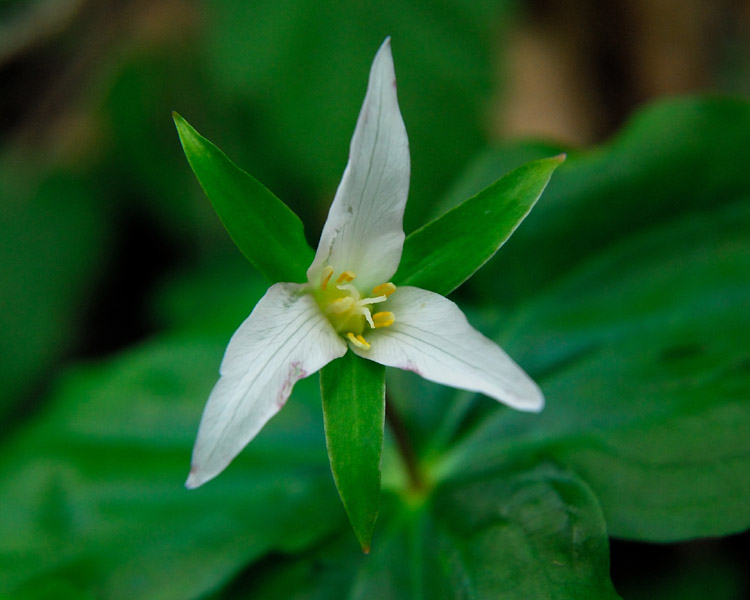

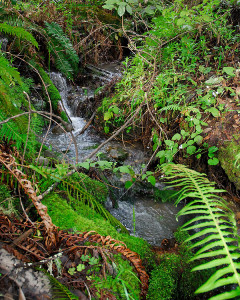
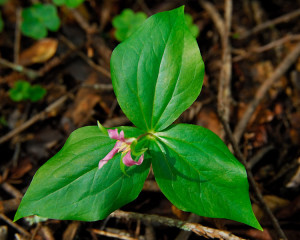
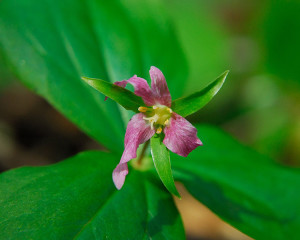
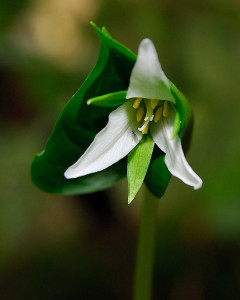
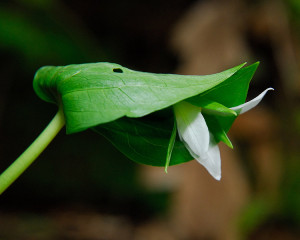


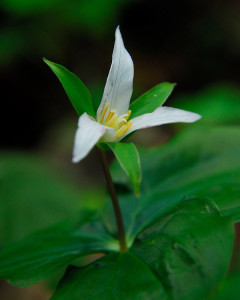








I can’t think of anything that says lush Springtime better! The emerging flower looks like a lady’s skirt caught in the wind. So lovely and thanks for sharing!
Trillium is such a wonderful sign of spring. Two years ago, I saw some painted trillium growing along the side of my dirt road, and I have hopes that it may return this year. -Jean
Lovely. We don’t have this trillium so I was really interested to see it. We have red, large white, and painted, plus i have yellow in my shade garden, but the latter isn’t native here.
You always share with us the most delicate jewels of the wild! Beautiful post!
Dear CV, Oh how wonderful to have Trilliums growing wild on your property. I love these plants but really struggle with them in my garden.
I love trillium…I love the side-view photo in which the leaf looks like a hood over the emerging flower 😀
Wow enjoyed reading about this trillium I have never seen, such nice photos too! Would not have thought it would be blooming so early in the season.
Jean, I do hope your painted Trillium return this year.
Edith, we are very fortunate to have them wild here. I can see why they can be challenging to cultivate in a garden. Even here they are very particular about where they grow, and they are not prolific by any degree.
Kyna, I think the side view is my favorite, in part because I’ve never seen Trillium at that stage before. I posted it in part because most photographs I saw on the web were of Trillium in full bloom, not at this emergent stage. I’m sure there must be others that didn’t realize the leaves protect the blossom that way.
Randy, I was a bit surprised to find them blooming already. I was still out hunting for mushrooms 😛 I think with all the rain we’ve had such a mild mid-late winter, with no frost since early December, and the Trilliums have been fooled into thinking it’s already spring.
Trilliums are simply the most magical plants. When I find them in the wild, and it’s only been a few instances, the memories have remained among my most treasured times in nature.
This is a brilliant post, Thank you!
Alice
I have tried growing Trilliums in my garden but have not had much luck – soil too light I expect. One survives and it is very precious to me. The way T. ovatum opens is fascinating.
aloha,
what a beautiful post, this reminds me of the frequent hikes i used to do in the redwoods at armstrong woods in guerneville and the trilliums were everywhere and what a treat when they bloom…you captured them well in your photos 🙂
Beautiful! I love trillium! And they’re very hard to find for sale.
How lucky you have them on your property. Thanks so much for sharing!
Another beautiful little flower that is completely new to me. The way it unfurls leaves and flower is just lovely!
It is a beautiful little plant. lucky you to have them growing wild.
72 years? Amazing! Such an interesting plant, and very lovely too!
What a wonderful blog! And what a thrill to find trilliums growing in the wild…I have tried to grow them from seed with no luck, but was very excited a few years ago to find purple trillium growing wild in an area of our property that we stopped mulching….
Thanks for sharing!
What a magic moment to capture! Good to know about the what you are in for if you decide to try propagating these beauties! I saw one on our property this weekend, but was too busy-busy to stop and really look at it. No bloom. Will have to get out looking for it again. The nearby woodland road where spring wildflowers grow has been calling to me but I can’t hear it over the roar of weeds.
I have a passion for Trillium. So far I have only found a single plant growing on my property. I’ve considered starting them from seed but it’s quite intimidating!
They are quite stunning. I saw some on a hike I did last weekend on Mt. Tam. Probably 8-10 or so over the course of a quarter mile. The most I’ve ever seen. I had no idea the leaves covered the flower like that. Very cool looking. If you do succeed in propagating them you can sell them for quite a bit. Minus the 7 years care. The Tilden Botanical garden usually has a few for their annual spring sale, but they are snapped in the first minute.
Indian women [in North America] claimed that boiled trillium root could arouse a man’s love [from ‘Wildflowers Across America’ National Geographic magazine Apr 1988]
What ever about arousing a man’s love they certainly arouse mine. Is it their almost prehistoric look or paper like quality, their fragility? I’m not sure but I am forever mesmerised by them
.-= Ena Ronayne´s last blog ..Prepare Now for a Relaxing Summer =-.